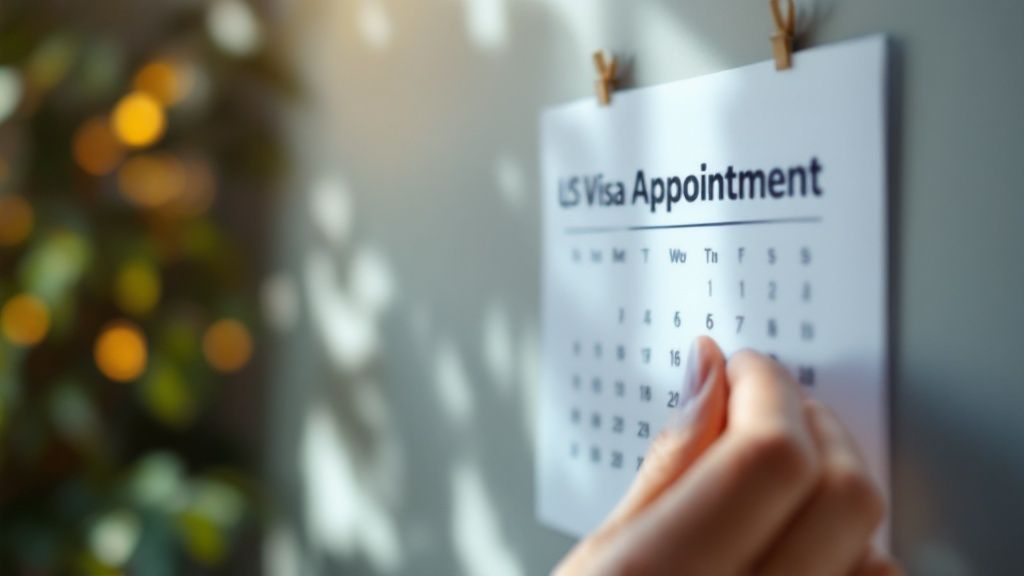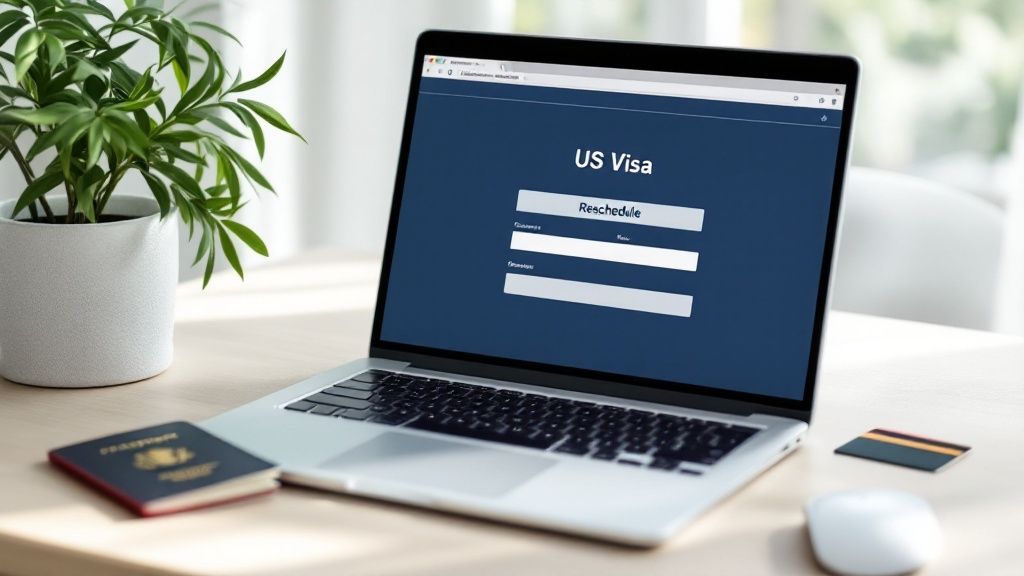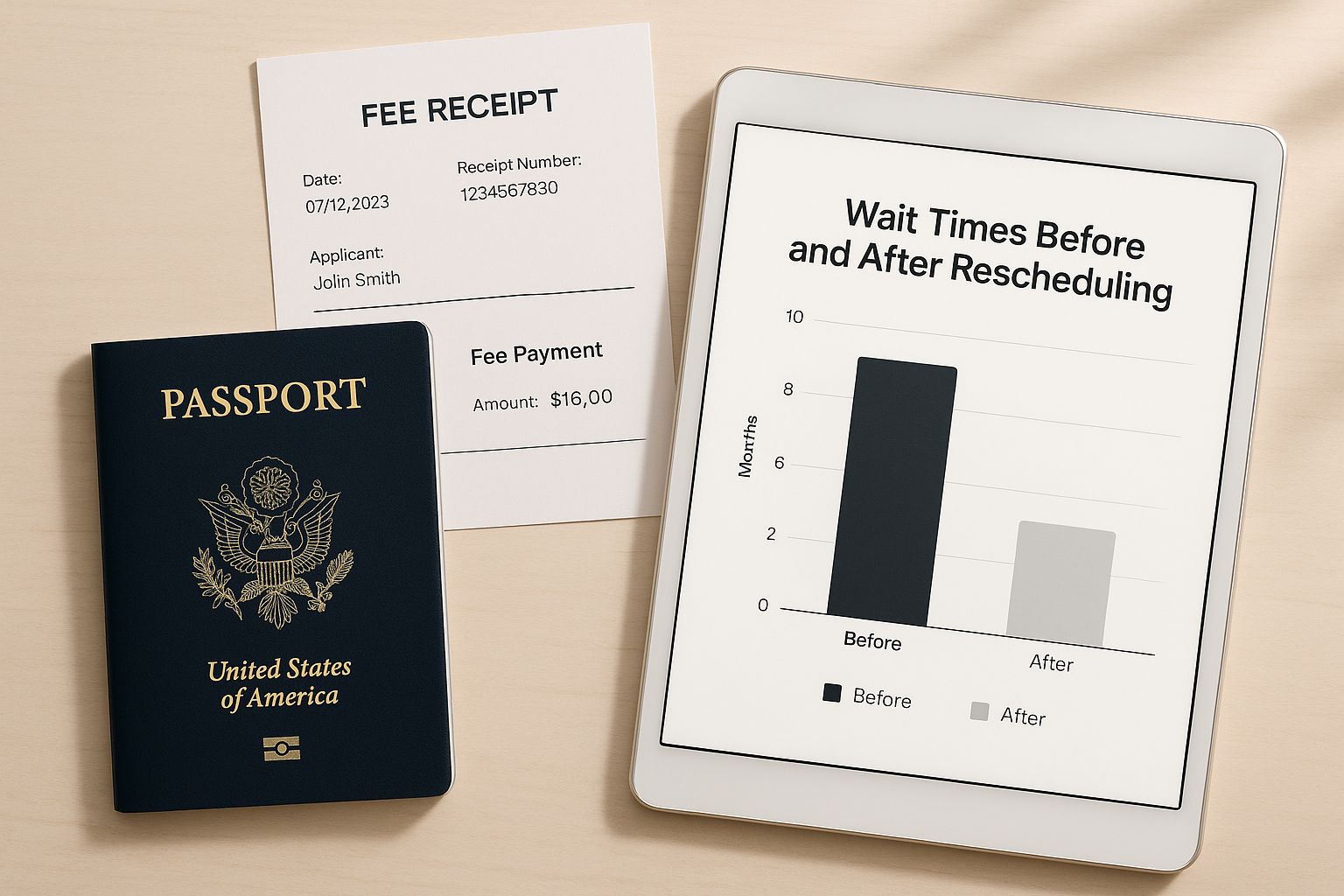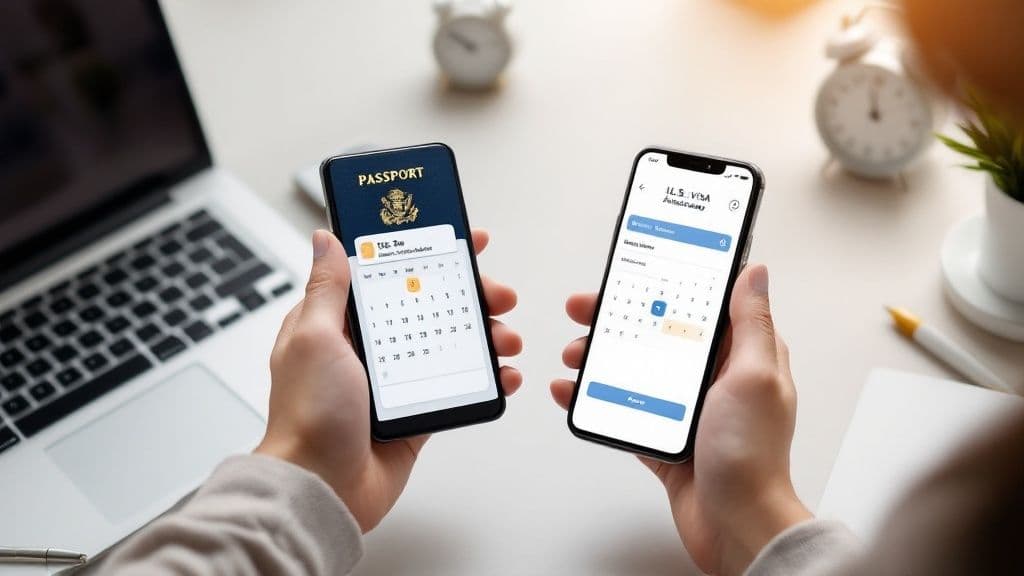Thinking about changing your U.S. visa appointment? You need to be more careful than ever. These days, you typically get only one free reschedule. If you need to change it again or miss your slot, you'll likely have to pay the entire visa fee all over again. This isn't just a minor rule—it's a strict policy put in place to manage the huge demand and cut down on backlogs.
Navigating the New Rules of Rescheduling

Life happens. A sudden work trip, a family emergency, or realizing you’re missing a key document—these are all legitimate reasons to move your U.S. visa interview. We get it. But the process for making that change isn't as forgiving as it used to be.
This shift in policy means you have to be absolutely strategic. The decision to use your single free reschedule shouldn't be made on a whim. Knowing the rules inside and out is the only way to avoid losing your visa fee, which can be a significant amount of money.
Why Planning Your Reschedule Is So Important Now
The U.S. Department of State has tightened its policies to handle the sheer volume of visa applications. It’s a global rule: applicants are now limited to a maximum of one free reschedule for their nonimmigrant visa appointment. A second change or a no-show means you forfeit your fee and have to start over by paying again to book a new slot. As you can read on platforms like Terra Tern, this change is designed to curb the high demand and reduce the long wait times seen in major consulates.
With so much on the line, solid planning is your best friend. Before you even think about hitting that "reschedule" button, take a moment to be certain about a few things:
- Your Availability: How confident are you that the new date will work? Another change will hit your wallet.
- Your Documents: Are all your papers in order? Make sure you have everything from your passport to the DS-160 confirmation page.
- The Financial Risk: Are you prepared to pay the fee again if something else comes up?
The bottom line is this: Treat your one free reschedule like a precious, one-time-use pass. Using it without a concrete plan can turn a simple scheduling conflict into a costly and frustrating delay on your path to getting a visa.
So, you need to change your U.S. visa appointment. The good news is that it’s entirely possible through the official U.S. Visa Scheduling portal. The key is getting comfortable with the new interface, as the whole system recently got a major overhaul.

This isn't the same platform many people used in the past. The global system upgrade introduced a completely redesigned portal for managing your profile and booking appointments. The biggest shift? Now, every single applicant, even infants, needs their own profile tied to a unique email address. It’s a significant change, and you can read the official announcement to understand how these changes to U.S. visa services affect applicants worldwide.
Getting Started: Your First Steps to Reschedule
First things first, you'll need to log into the official U.S. Visa Scheduling website for your specific country. This is your gateway, and getting this step right is crucial.
You'll be asked for the email and password you used when you first set up your account. If you created your profile before the big system update, don't be surprised if the site prompts you to reset your password or update some information to get your account aligned with the new requirements.
After logging in, you'll land on your personal dashboard. Think of this as your mission control center. Your current appointment details should be front and center, and right next to them, you should see an option like "Reschedule Appointment." That's the button you're looking for.
Selecting a New Date and Locking It In
Once you click to reschedule, a calendar will pop up showing all available dates. This is often the most challenging part of the process. Open slots can be incredibly hard to come by and they disappear fast.
- Patience is your best friend. You might have to log in and check the calendar repeatedly over a few days or even weeks. New appointments are released sporadically, not on a predictable schedule.
- Flexibility is a superpower. The more open you are with your dates and times, the better your odds of snagging a spot.
When you finally find a date that works, select it and carefully follow the prompts to confirm. The system will give you one last chance to review the new details before making it final. Once you confirm, a new appointment letter will be sent to your email.
Crucial Tip: You typically only get a limited number of "free" reschedules. After you've used them up (the number can vary, but it's often just one or two), you'll likely have to pay the entire visa fee again to make another change. Be absolutely sure about the new date before you commit.
After you've confirmed, print the new appointment confirmation immediately. Throw the old one away to avoid any mix-ups on your interview day.
Don't Forget This Critical DS-160 Update
Here’s a step that trips up so many applicants: updating your DS-160 confirmation number in the portal.
If you submitted a new or updated DS-160 form after you booked your original appointment, you must go back into your U.S. Visa Scheduling profile and update the DS-160 confirmation number there.
Why is this so important? The barcode on the DS-160 confirmation page you bring to the interview has to match the number in your scheduling profile. If they don't match, you could be turned away at the consulate. That would count as a missed appointment, and you'd lose your visa fee. It’s a simple fix that can save you a world of trouble—just find the "Update Profile" or similar option on your dashboard and swap in the new number.
Understanding the Costs and Policy Limits
Think of your Machine Readable Visa (MRV) fee—that $185 or more you paid—as a single-use ticket. The "one free reschedule" rule isn't just a friendly suggestion; it's a hard limit with real financial teeth. Once you use that one freebie, any more changes or a missed appointment will almost certainly mean you're paying that fee all over again.
This isn't just about bureaucracy. This policy is in place to keep the appointment system moving and cut down on no-shows. In a system with overwhelming demand, every last-minute cancellation or no-show is a slot that another applicant could have desperately used. The fee penalty is there to make sure everyone takes their appointment date seriously.
When Your Reschedule Turns Costly
Let's walk through a common scenario. You snag an appointment for July, but a work project comes up, so you reschedule it for September. That’s it—you've used your one free change.
Then, a week before the September date, a true family emergency happens, and you absolutely can't make it. Now you're in a bind. If you try to change that September date, the system won't just let you pick a new one. It will lock you out of the calendar until you pay the entire MRV fee again.
This visual gives you a good idea of how a seemingly simple reschedule can affect your timeline.

It's also crucial to know what counts as a "missed appointment." It's not just about not showing up. I've seen applicants turned away at the consulate door for a simple mistake like an incorrect DS-160 number or forgetting a key document. That's often marked as a no-show, and just like that, their fee is gone.
Your first reschedule is your only safety net. Using it for a minor inconvenience can leave you financially exposed if a true emergency arises later. Carefully weigh the necessity of any change before you commit.
Reschedule Scenarios and Fee Implications
To make it crystal clear, I've put together a table breaking down how different situations play out with your visa fee.
| Scenario | Number of Reschedules Used | Fee Impact |
|---|---|---|
| First-time reschedule for a better date. | 1 | No fee impact. This is your one free change. |
| Emergency forces a second reschedule. | 2 | Full MRV fee payment required before a new date can be booked. |
| Missed appointment (no-show). | 0 or 1 | Full MRV fee payment required. Your initial fee is forfeited. |
| Turned away at the consulate (wrong DS-160, missing documents, etc.). | 0 or 1 | Often treated as a no-show. Fee is forfeited, and a new one must be paid. |
This table highlights just how quickly a situation can become costly. The key is to protect that first reschedule at all costs.
Paying the MRV Fee a Second Time
If you do end up in a situation where you have to pay again, you're essentially starting over from a financial standpoint. You'll need to go back into the scheduling portal, generate a new fee payment slip, and pay the full amount.
Once that new payment has been processed and shows up in your profile—which can take a few business days—the calendar will unlock, and you can book a new appointment. Your old appointment is gone, and this new fee receipt is now tied to your profile.
At the moment, Vast Fisa supports only B1 and/or B2 visa applicants in select markets, including Canada, Colombia, Costa Rica, the Dominican Republic, Ecuador, Guatemala, Honduras, Mexico, Peru, Uganda, and Zambia. For applicants in these high-demand countries, this process can be particularly stressful. Having a tool monitor for earlier appointment dates can be a game-changer, helping you find a better slot without burning your one free reschedule on a date that isn't ideal. It helps you save that precious freebie for a genuine, unforeseen emergency.
So, why is it so hard to find an open appointment slot? Let's get into it.
https://www.youtube.com/embed/9bMSwxwpazk
If you’ve logged into the visa portal and stared at a completely blank calendar, take a deep breath. You’re not alone. It’s an incredibly frustrating experience that makes a lot of people think the system is broken or that they’ve made a mistake.
The truth is, this isn’t a technical glitch. It's a classic case of supply and demand—and the demand is overwhelming. U.S. consulates and embassies simply don't have the capacity to meet the sheer volume of applications.
When you try to reschedule a US visa appointment, you're jumping into a digital arena with thousands of other applicants. Everyone is competing for a handful of openings that often get claimed within seconds of appearing.
The Forces Behind the Scarcity
A few key factors are at play here, and understanding them can help you set realistic expectations and build a smarter strategy for checking the portal.
- Massive Backlogs: Many consulates are still digging out from appointment backlogs that piled up over the last few years. This creates a bottleneck, severely limiting how many new appointments can be offered.
- Seasonal Surges: Demand isn't consistent throughout the year. Think about the months leading up to the fall semester—that’s when a tidal wave of student (F-1) visa applications hits, swallowing up a huge chunk of interview slots.
- Operational Headaches: Consular operations are anything but static. A simple policy change, unexpected staff shortages, or even local holidays can suddenly shrink a consulate's interview capacity, making a tough situation even tougher.
The key takeaway here is this: an empty calendar doesn't mean no appointments will ever be available. It just means that at the exact moment you're looking, the supply has been completely exhausted. New slots do get released, but they're often gone in a flash.
A Reality Check on Wait Times
The situation on the ground can vary wildly depending on your location, and it can change from one month to the next.
Let's look at India, a massive source of U.S. visa applications. The data shows just how unpredictable things are. As of September, the wait for a B1/B2 visa interview in New Delhi had climbed to an astonishing 12 months. At the same time, Chennai’s wait time dropped from 8.5 months to a more manageable 2.5 months. You can dig into these fluctuations in U.S. visa appointment wait times to see just how volatile the landscape is.
This kind of unpredictability makes planning a reschedule of a US visa appointment feel like a gamble. If your travel is urgent, constantly refreshing the calendar for a slot can feel like an impossible task. For those facing a genuine emergency, it's worth seeing if you can expedite your US visa appointment.
Smart Strategies for a Successful Reschedule
Nailing a U.S. visa reschedule is less about luck and more about strategy. With thousands of applicants all competing for a handful of openings, you can't just sit back and hope for the best. You have to be persistent, prepared, and ready to act fast.
A question I get all the time is, "When is the best time to check the portal?" Honestly, there's no secret formula. But I’ve seen many people find success by checking at odd hours—I'm talking very early in the morning or late at night. Consulates release new and canceled slots randomly, so looking outside of normal business hours can definitely give you a leg up.
Have Everything Ready to Go
This is critical. When a good appointment date pops up, it can disappear in seconds. Literally. You don't have time to go searching for your DS-160 number or digging your passport out of a drawer.
Before you even think about logging in, get all your documents and information laid out in front of you.
- Your passport information
- The correct DS-160 confirmation number
- Your login details for the scheduling portal
Having this stuff on hand means you can click and confirm the second you see an opening. It’s the single best way to beat others to the punch. For a full rundown of what you'll need, check out our complete guide on U.S. visa appointment booking.
Let Technology Do the Heavy Lifting
Manually refreshing the appointment page over and over is a recipe for frustration. Worse, it can get your account temporarily locked for what the system sees as suspicious activity. This is where a little automation can make a huge difference, especially if your travel is urgent.
If you're a B1/B2 visa applicant, there are tools designed to watch the calendar for you.
Vast Fisa, for instance, helps B1/B2 applicants in certain countries by scanning for earlier dates 24/7. The moment a slot opens, you can get an alert, giving you the chance to grab it immediately. It takes the tedious, stressful work off your plate and ensures you don't miss a fleeting opportunity.
At the moment, Vast Fisa supports only B1 and/or B2 visa applicants in select markets, including Canada, Colombia, Costa Rica, the Dominican Republic, Ecuador, Guatemala, Honduras, Mexico, Peru, Uganda, and Zambia. Using a service like this can transform the waiting game from a source of anxiety into a manageable, strategic process.
Common Questions About Rescheduling Your Visa Appointment
Even when you know the steps, rescheduling a U.S. visa appointment can feel like navigating a maze. A few tricky "what if" scenarios always seem to pop up. Let's walk through some of the most common questions I hear from applicants so you can avoid any last-minute surprises.
One of the first things people wonder is whether they can just move their appointment to a different country, especially if a neighboring one has much shorter wait times. Unfortunately, the answer is almost always no. Your visa application, and more importantly, the MRV fee you paid, are locked into the country where you first applied.
If you absolutely must switch countries, you're essentially starting over. That means filling out a brand new DS-160, paying another fee in the new country's currency, and scheduling from square one. It’s a costly and time-consuming reset, which is why choosing your application country carefully from the get-go is so important.
Handling Your DS-160 Form and Checking Dates
So, what happens if you realize you need to submit a new DS-160 form after you’ve already booked an appointment? This is a critical detail. If you update your DS-160, you must log into the visa scheduling portal and update your profile with the new confirmation number.
Don't skip this step. Showing up with a DS-160 confirmation that doesn't match the number in the system is a surefire way to be turned away. Consulates often treat this as a missed appointment, meaning you could forfeit your fee. As a backup, I always advise bringing printouts of both the old and new DS-160 confirmation pages.
A lot of applicants get nervous that just looking for new dates will use up their reschedule attempt. You can relax on that one. The system allows you to browse the appointment calendar as many times as you want without penalty. A "reschedule" only officially happens when you select a new date and hit that final confirmation button.
One quick tip: try not to log in and out obsessively. Doing it too many times in a short period can trigger a temporary security lockout on your account. Checking a few strategic times a day is a much better approach.
Rescheduling After a Refusal
What if you face a 221(g) refusal? This is when the consular officer needs more information or documents before making a final decision. If they ask you to return for another interview after you've submitted the required paperwork, this follow-up appointment generally does not count against your reschedule limit.
The consulate will give you specific instructions on how to book this next meeting, as it's considered a continuation of your original application.
Getting these small details right makes a huge difference. For example, making sure your documents are perfect from the start can prevent a 221(g) in the first place. Our B-2 visa documents checklist is a fantastic tool to help you get everything in order.
Tired of the endless refreshing and the stress of trying to find an open slot? Vast Fisa can handle the heavy lifting for you. Our service keeps an eye on the visa portal 24/7, alerting you instantly—or even automatically rescheduling your appointment—the moment an earlier date becomes available. Visit https://www.vastfisa.com and see how we can get you an earlier appointment without all the hassle.
